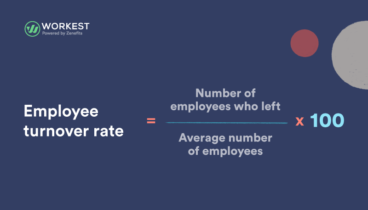Headcount at the beginning of Q1 = 50
Headcount at the end of Q1 = 57
(50 + 57) / 2 = 53.5
Employee turnover rate example:
Number of employees who left in Q1 = 7
Average number of employees in Q1 = 89
(7/89) * 100 = 7.9%
Employee turnover costs
Turnover costs include all the expenses generated when employees leave and an organization has to replace them. Total-cost estimates range from representing months' worth of the departing employee's regular pay to up to twice that employee's
annual salary.
Calculating turnover costs involves determining or estimating the cost of a wide range of factors. It’s worth the effort. Knowing how much employee turnover drains your organization can help you determine your most cost-effective employee retention strategy.
How to calculate a company's employee turnover costs
Employee turnover costs will vary greatly, depending upon factors such as company size, industry, employee wages or salary, and more. Organizations typically measure turnover variables such as:
- Money paid to employees when they leave. This may include their last paychecks, accrued vacation pay, and any severance or bonus packages.
- Increases in unemployment tax.
- Administrative costs involved in handling the employee’s exit.
- Costs of hiring temporary workers until the position is filled.
- Lost productivity while the position is open.
- Costs of recruiting a replacement. Expenses often involve advertising, recruitment companies, resume screening, interviews, background checks, and relocation.
- Costs of onboarding the new employee, including training courses and orientation materials.
Less-measurable costs can include:
- Loss of organizational knowledge.
- Loss of client relationships.
- Missed deadlines.
- Lower morale among remaining workers due to overwork.
- Possible chain reaction of other employees leaving.
- The new employee’s learning curve.
A basic formula that you can use to
calculate turnover costs is:
Cost of processing employee exits + cost of replacing employees + cost of lost productivity.
Lost productivity and employee turnover
The cost of lost productivity may be difficult to measure precisely. So as you calculate employee turnover costs in this realm, you may have to estimate. Factor in that they exceed losses that occur because employees left and their positions are still vacant. Even after those positions are refilled, productivity losses can remain as the
new hire gets up to speed.
Moreover,
employee turnover is disruptive to the social environment at work. Employees and their roles are interconnected. Changes ripple out to affect groups as a whole. This disruption can occur at all levels of an organization, from the C suite to the floor or field. Changes in work groups can cause morale and motivation to drop. In turn, this can impact the turnout of the organization’s products or services.
Assessing your company's turnover rates and impact for growth-related insight
In short, the higher the employee turnover rate, the more an employer has to pay. A company can save significant money by addressing a high turnover rate and the causes.
The first step is to gain accurate knowledge of the extent of the problem. Knowing
how to calculate employee turnover and associated costs will provide that information. From there, organizations can strategize for how to reduce employee turnover for long-term growth and prosperity.
Count on TriNet throughout the day for ongoing HR and business management news, tips, and resources.

 To calculate your employee turnover rate, first calculate the average number of employees in a given time span. To do so, add your starting headcount to your final headcount for the specified period of time, and divide by 2.
Average Number of Employees = (Headcount at the beginning of the timeframe + Headcount at the end of the timeframe) / 2
To calculate your employee turnover rate, first calculate the average number of employees in a given time span. To do so, add your starting headcount to your final headcount for the specified period of time, and divide by 2.
Average Number of Employees = (Headcount at the beginning of the timeframe + Headcount at the end of the timeframe) / 2


